Public Institute Belana Cirkulane PE Grad Borl, Dolane 1, 2282 Cirkulane T: 031 466 006 E: info@visitborl.si
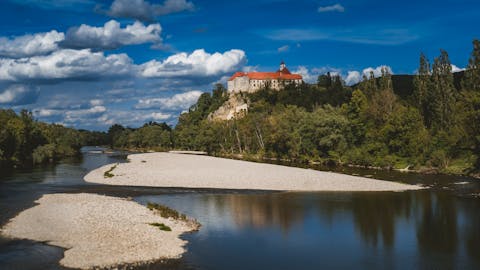
CIRKULANE MUNICIPALITY
Borl Castle
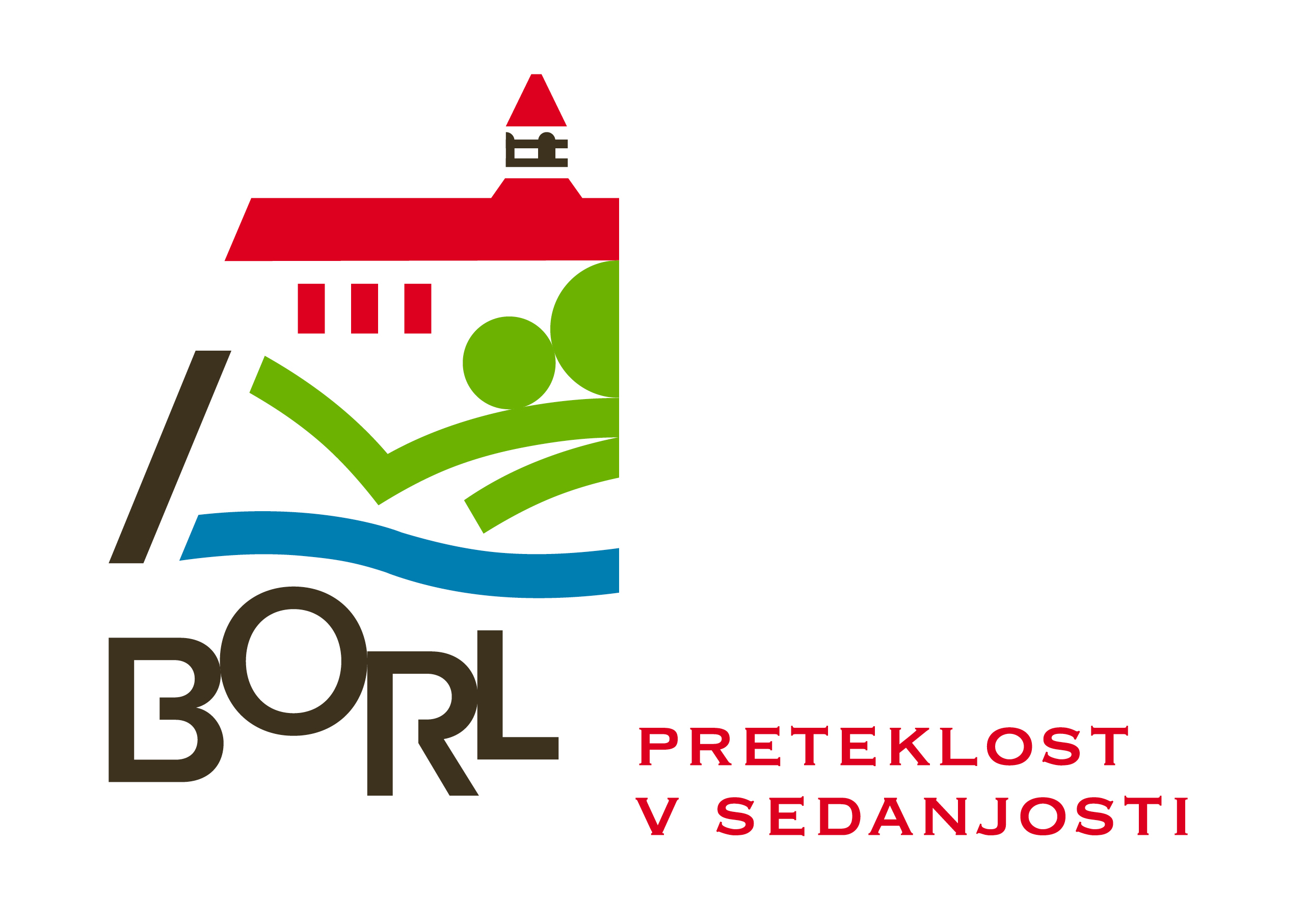
ONCE ANKENSTEIN OR BORLYN, TODAY BORL
The silhouette of Borl Castle can be seen from afar, which is why it is rightfully called the gateway to the Haloze region. It has stood majestically on a steep cliff above the Drava River since the 12th century, guarding a strategically important crossing over the river – a fact reflected in its Hungarian and German names, Borlyn and Ankenstein.
Among Borl’s most notable owners was the Sauer family, who in the 17th century transformed the castle into a comfortable residence, richly furnished it, and through numerous additions gave it its present Baroque appearance. It remained in their possession until 1801, after which it passed to the Wurmbrand-Stuppach family, who thoroughly renovated and elegantly furnished the castle in the mid-19th century. From 1901 to 1922, it was owned by Max Kübeck and Adalberta Kübeck, née Wurmbrand–Stuppach. They made the castle their home but, due to the political situation after World War I, sold it to the Borlin joint-stock company. The 196-hectare Borl Castle estate fell under the agrarian reform.
During World War II, the occupiers turned the castle into an internment camp for Slovenian patriots. After the war, it was nationalized and converted into a hotel with a restaurant and swimming pool.
At the end of the 1970s, the castle was closed and began to fall into disrepair. The members of the Society for the Revival of Borl Castle worked tirelessly for its restoration and reopening. In 2020, long-awaited restoration work began, allowing the castle to be partially reopened to the public.
From the castle park, the central castle tower – the bergfried, with walls in some places more than 12 meters thick – can be clearly seen.
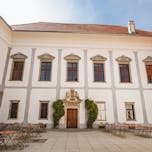
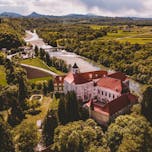

BORL CASTLE RESORT
A time when the castle opened its doors wide
For just under thirty years, from 1952 to 1979, Borl Castle was home to the Borl Castle Resort. This is a period still fondly remembered by some, as it was here they danced, ate well, enjoyed themselves, swam in the pool, or even met their sweetheart. The castle’s offerings are often mentioned as a pillar of tourism development. At its best, the resort had a capacity of 1,200 seats and 120 beds, with a rich culinary selection and live music on weekends. In a single weekend, they would sell up to 1,000 liters of Haloze wine and serve 700 kilograms of meat.
During this period, many events and gatherings took place: from concerts, weddings, performances by brass bands, choirs, and folklore groups, to meetings of Slovenian partisans, a stopover for the rafting expedition from Maribor, reunions of former internees and expatriates, seminars, trade union trips, painting colonies, New Year’s Eve parties, St. Martin’s Day celebrations, and midsummer bonfires.
Due to the construction of the new road to Zagreb, the demolition of the Drava River bridge, the urgent need for renovation works on the building, and, not least, the opening of a hotel and spa in Ptuj, the Borl Resort ceased operating.
The swimming pool, opened in 1962, could accommodate up to 500 bathers in fine weather.
A jewel above the Drava today
Today, the castle is owned by the Republic of Slovenia and holds the status of a monument of national importance. One third of the castle was restored in 2020, and in 2024 it was reopened to the public.
The castle is adorned with large inner and outer arcaded courtyards, as well as an outdoor terrace with views of the ancient town of Ptuj. Beneath the castle is a two-storey Z-shaped cellar. The castle chapel, dedicated to the Holy Trinity, was built and richly furnished in the 17th century. The main altar was once decorated with a depiction of Count and Countess Sauer, holding an image of the castle in their hands, but this was stolen at the end of the 20th century and has never been recovered.
For visitors, there is the natural history exhibition “zDravo” on the importance of the biodiversity of the Drava riverbank area within Natura 2000. On the site where the swimming pool once stood, there is now a wetland that has become home to numerous animal and plant species.
The castle houses a café. The historic character of the castle complex offers a space for organising various events, meetings, workshops, concerts, and weddings.
Bats have also found their home here – specifically two protected species: the greater horseshoe bat and the Geoffroy’s bat.
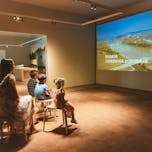


PLACES OF INTEREST IN THE SURROUNDINGS
HERITAGE PARK CIRKULANE , Cirkulane 68
This open-air ethnological museum offers insight into the traditional way of life and work of our ancestors. It consists of a Haloze-style timbered house from the early 19th century, a stable, a wagon shed with a barn, a herb garden, vineyards, and a beehive.
PARISH CHURCH OF ST. BARBARA
The Church of St. Barbara has been the seat of the parish since 1784. It was founded by Count Jurij Friderik Sauer after a severe plague in the early 17th century. On the choir loft, there is a fresco of Cirkulane from 1819. The church is distinguished by its impressive Baroque bell tower, which, at 52 metres, is among the tallest in Slovenia.
ST. ANNE, VELIKI VRH 15
In Veliki Vrh stands the Church of St. Anne from the 17th century, offering a beautiful view of the surroundings. It was built at the initiative of the Sauer counts, then owners of Borl Castle. According to local tradition, future parents must circle the church twice on their knees to obtain the blessing of having twins. In the immediate vicinity, there is a well-kept educational vineyard.
MEMORIAL ROOM OF DR. VLADIMIR BRAČIČ
Dr. Vladimir Bračič, a renowned educator, geographer, politician, and the first rector of the University of Maribor, was born in Cirkulane on September 27, 1919. In his research work, he focused on social geography and devoted much attention to the Haloze region and his native Cirkulane. In his birthplace (the Rajher House) in the centre of Cirkulane, a memorial room has been arranged.

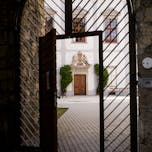

Contact and Opening Hours
OPENING HOURS BORL CASTLE
Open on Friday, Saturday, Sunday, and public holidays
May, June, September, October: 10:00 AM – 6:00 PM
July and August: 10:00 AM – 8:00 PM
November – April: 10:00 AM – 4:00 PM
CONTACT BORL CASTLE
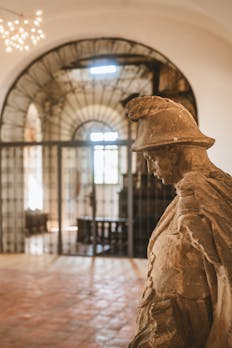

How to Reach Borl Castle
Grad Borl, Dolane 1, 2282 Cirkulane
Ptuj – 20 min
Maribor – 45 min
Ljubljana – 1h 50min
Zagreb – 1h 40min
Dunaj – 3h 15min